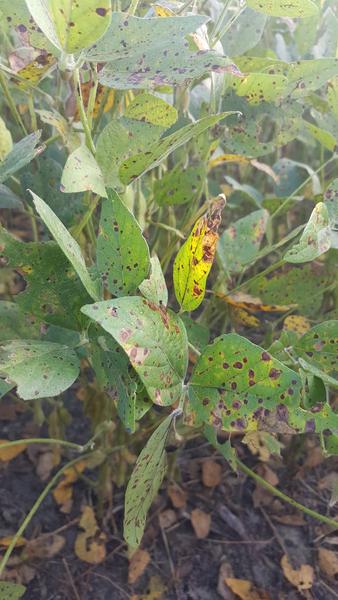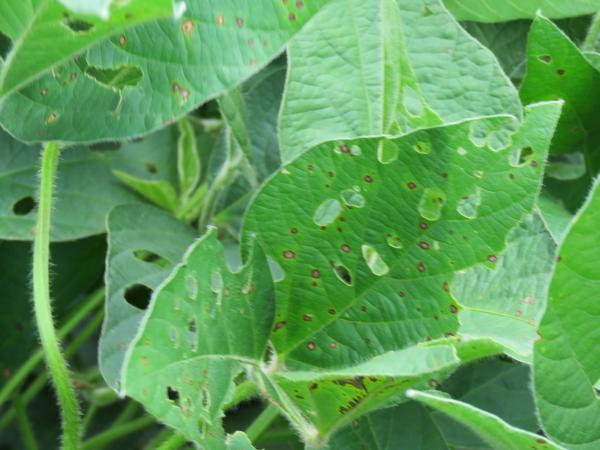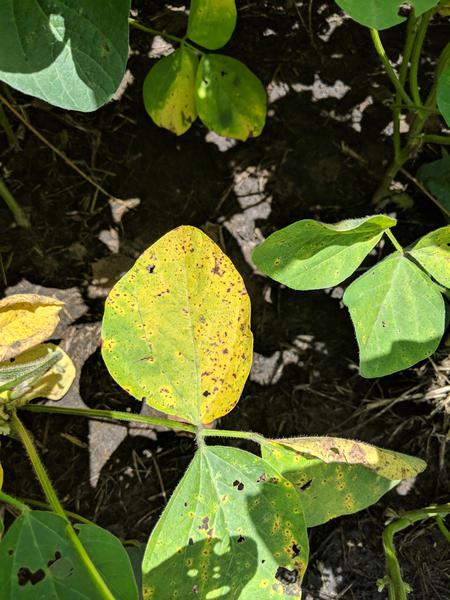Introduction
Target spot on soybean is a common pathogen in North Carolina; however, losses associated with disease are rare. Infection requires high humidity and long periods of high moisture with free water resting on tissue surfaces. The impact of this pathogen on agriculture is felt around the world, affecting cowpea in Africa, papaya harvests in tropical regions, tomatoes, cotton, and rubber trees.
Pathogen
Corynespora cassiicola is an ascomycete fungus known to infect well over 500 species of plants across 53 families. Due to the requirement of wet conditions for infection, disease is most commonly found in tropical and subtropical host species. Asexual spores (conidia) are the primary inoculum source for this disease. Within lesions, the hyphae of this fungus is produced and produces asexual reproductive structures called stroma. Conidia produced are club shaped, thick proximally and gradually narrowing distally. They are multi-septate, and brown pigmented.
Host Range
In addition to soybean, C. cassiicola has a wide host range including cucurbits, solanaceous plants, cotton, and a wide variety of horticultural plants.
Symptoms and Signs
Initial infection by target spot is generally seen forming lesions on the lower canopy leaves. The lesions are roughly ½ inch across, and round to irregular in shape. They are very dark brown, sometimes with a dark purple hue, usually forming concentric rings with varying shades of brown. There will often be a yellow halo surrounding the lesion. After the initial infection has matured, if conditions are favorable, conidia will form and may disperse to the upper canopy of the plant. As lesions age, centers of leaf spots may fall out causing a shot-hole appearance. In cases of heavy infestation, defoliation can occur.
Diseases with Similar Symptoms
Frogeye leaf spot (Cercospora sojina, Figure 2).
This disease produces small brown lesions that will be pale brown to white in the center and dark brown along the margin. Spots are round to irregular and vary in size from ⅛ to ¼ inch across. Early infection, before pale region forms in the center of the spot, frogeye leaf spot can resemble early infections of target spot.
Brown spot (Septoria glycines, Figure 3).
Brown spot causes small brown lesions that may produce concentric rings. Early lesions also appear similar to immature target spot lesions, which may make identification difficult.
Disease Cycle and Favorable Conditions for Disease
Target spot generally requires very wet conditions, with free water resting on the leaves for infection to take place. Wet, warm conditions persisting for several days can result in a sudden increase in target spot infection.
C. cassiicola overwinters in plant debris and soil. The conidia are dispersed by water and air to reach susceptible tissues on plants. The spores will germinate and infect the tissue of the leaf. As the pathogen grows, dead tissue begins to form the lesion. Fruiting bodies (stroma) form and erupt from the leaf tissue. Spores form on the stroma, and are released. The fungus can persist in the soil for several years.
Management
Cultural practices are important to limiting disease losses. Since conidia persist in the soil for several years, crop residue destruction can be an important strategy in reducing recurring infection. Corynespora cassiicola has many alternative host species, including common rotations and weed species. Managing weed hosts and a crop rotation schedule which excludes hosts for several years is important to reduce disease.
Fungicides are effective at reducing disease; however, damages rarely are severe to require fungicide applications in the state. Scouting during critical growth stages (R3-R5) is important to identify the presence of disease and conditions that may require the use of a fungicide application. Resistance to QoI fungicides has been identified in the United States, which reinforces the importance of rotating fungicide modes of action when spraying to control pathogens. If a fungicide application is required for disease pressure, a mixed mode of action fungicide is beneficial to reduce disease and limit risk of fungicide resistance development.
Useful Resources
The NC State University Plant Disease and Insect Clinic provides diagnostic and control recommendations.
The NCSU Extension Plant Pathology portal provides information on crop disease management.
The North Carolina Agricultural Chemicals Manual provides pesticide information for common diseases of North Carolina Crops. Recommendations do not replace those described on the pesticide label, the label must be followed.
Your N.C. Cooperative Extension agent.
Acknowledgements
This factsheet was prepared by the NCSU Field Crops and Tobacco Pathology Lab in 2020.
- Check out our Facebook and our Twitter!
Publication date: Sept. 8, 2020
N.C. Cooperative Extension prohibits discrimination and harassment regardless of age, color, disability, family and marital status, gender identity, national origin, political beliefs, race, religion, sex (including pregnancy), sexual orientation and veteran status.
NC Cooperative Extension prohíbe la discriminación por raza, color, nacionalidad, edad, sexo (incluyendo el embarazo), discapacidad, religión, orientación sexual, identidad de género, información genética, afiliación política, y estatus de veteran.
The use of brand names in this publication does not imply endorsement by NC State University or N.C. A&T State University of the products or services named nor discrimination against similar products or services not mentioned.
Recommendations for the use of agricultural chemicals are included in this publication as a convenience to the reader. The use of brand names and any mention or listing of commercial products or services in this publication does not imply endorsement by NC State University or N.C. A&T State University nor discrimination against similar products or services not mentioned. Individuals who use agricultural chemicals are responsible for ensuring that the intended use complies with current regulations and conforms to the product label. Be sure to obtain current information about usage regulations and examine a current product label before applying any chemical. For assistance, contact your local N.C. Cooperative Extension county center.
N.C. Cooperative Extension prohibits discrimination and harassment regardless of age, color, disability, family and marital status, gender identity, national origin, political beliefs, race, religion, sex (including pregnancy), sexual orientation and veteran status.




